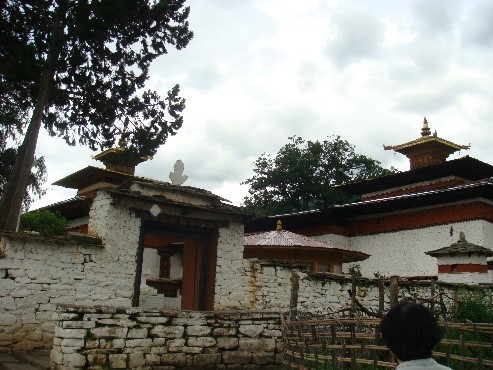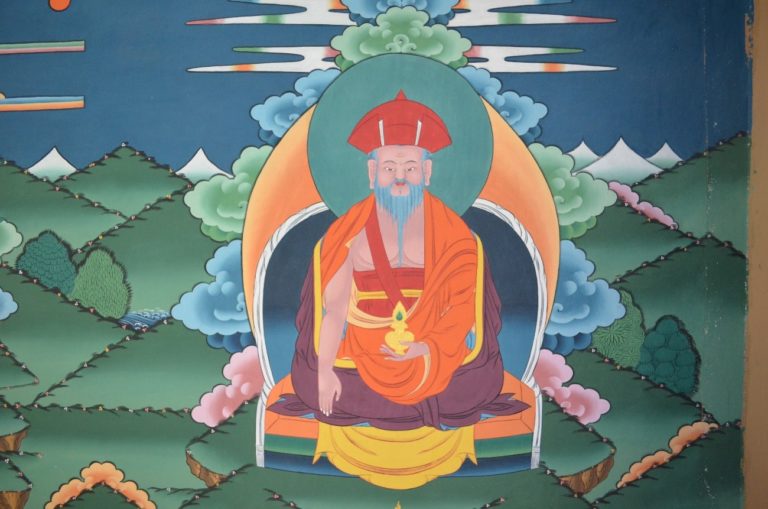According to the archaeological view of a researcher, it seems that people had settled in the land of Bhutan from around 4000 years ago. However, it is unclear how the Bhutanese people lived in that era. The historic period in which historical events can be verified through history books and oral traditions can be roughly divided into the following three periods.
- Before the founding the country by Zhabs Drung (7th to early 17th century)
- Druk lineage era (first half of 17th century to 1907)
- The Wangchuck dynasty (1907- )
1. Before the founding the country by Zhabs Drung (7th to early 17th century)
The land of Bhutan was first unified and became a nation only in the 17th century. However, even before that, people lived, and culture existed in Bhutan.
Since the 7th century, as the southernmost country of the Tibetan cultural sphere, it has been greatly influenced by Tibet. According to the Bhutanese tradition, in the first half of the 7th century, King Songtsen Gampo (581-649) of Tibet built Buddhist temples such as Kyichu Lhakhang (Paro in West Bhutan). There are also temples such as Taktsang Temple (Paro in West Bhutan), which are attributed to Indian yoga practitioner Padmasambhava (Guru Rinpoche) who was said to have visited Bhutan in the 8th century.

In Tibet, the dynasty collapsed in the 9th century, and Buddhism also fell into a decline. While Buddhism was revived in Tibet since the 11th century, Tibetan Buddhist denominations began to spread their beliefs in the land of Bhutan to the south and promoted manorialization. Due to the limited resources available in the Tibetan Plateau, which exceeds 3000 meters, Bhutan, which is rich in products such as rice, wood, paper, herbs, dyes and bamboo products, was a very attractive region for the Tibetan side. The Drukpa, which later became the national religion of Bhutan, began to advance to Bhutan in the 13th century.
2. Druk lineage era (first half of 17th century to 1907)
It was in the first half of the 17th century that the Drukpa, which had a base in the central and southern part of Central Tibet, changed. After the death of Pema Karpo (1527-1592), the greatest Drukpa in history, two candidates for avatars appeared. One was the 17th chairman of the Drukpa, Zhabs Drung Ngawang Namgyal (1594-1651), and the other was Pagsam Wangpo (1593-1641). Following the fact that the Tsang regency recognized the latter as a legitimate incarnation, Zhabs Drung was said to have moved from Tibet to Bhutan to avoid conflict.

When Zhabs Drung moved to Bhutan, a conflict with the local Buddhist forces called the Lama Five faction was born and they were attacked. While fighting against those forces and repelling them, Zhabs Drung spread their powers throughout Bhutan. The Drukpa led by Zhabs Drung unified the land of Bhutan, and Bhutan, which was only a part of the Himalayas, became the unified state for the first time. Since then, Bhutan has been called “Druk yul” in the local language. The Bhutan name is the English pronunciation of the Sanskrit word Bhoṭānta, the end of Tibet. Since then, the religious regime of the Drukpa has continued for a long time.
3. The Wangchuk Dynasty (1907-)
In the 19th century, due to the interference of Britain and India, the nation’s operations became unstable and there were many civil wars. Under such circumstances, Ugyen Wangchuck (1862-1926), the lord of Central and East Bhutan, unified Bhutan and became the first King of Bhutan in 1907. Bhutan joined the United Nations in 1971, as modernization and internationalization progressed during the time of the third King of Jigme Dorji Wangchuck (1929-1972). In the era of the 4th King of Jigme Singye Wangchuck (1955-), modernization and internationalization were further promoted, and the Gross National Happiness (GNH) policy was launched, making the Kingdom of Bhutan the leader in global happiness policy. After the enthronement of Jigme Khesar Namgyel Wangchuck (1980-) as the 5th King, in 2008 the Constitution of the Kingdom of Bhutan was enacted, national elections began, and the absolute monarchy changed to aconstitutional monarchy.
